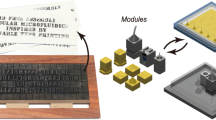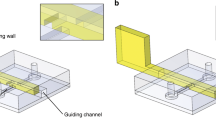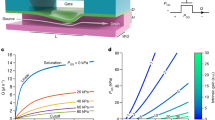Tiny free-floating drops can be driven across a liquid medium by an electric field.
Abstract
'Lab-on-a-chip' systems resemble factories with permanently rigged pipes, but their prefabricated microchannels could have problems in delivering materials such as suspended particles, biological cells or proteins, which may adhere to the walls and clog the channels. More flexible microfluidic systems allow liquids to be transported as droplets on a solid surface1,2,3,4,5,6,7,8,9,10, but these suffer from similar drawbacks where the droplets are in contact with solid walls. Here we describe a liquid–liquid microfluidic system for manipulating freely suspended microlitre- and nanolitre-sized droplets of water or hydrocarbon, which float on a denser, perfluorinated oil and are driven by an alternating or constant electric field applied by arrays of electrodes below the oil. These microfluidic chips could be used as a versatile tool in microscale transport and mixing and in chemical and materials synthesis.
This is a preview of subscription content, access via your institution
Access options
Subscribe to this journal
Receive 51 print issues and online access
$199.00 per year
only $3.90 per issue
Buy this article
- Purchase on Springer Link
- Instant access to full article PDF
Prices may be subject to local taxes which are calculated during checkout


Similar content being viewed by others
References
Chaudhury, M. K. & Whitesides, G. W. Science 256, 1539–1541 (1992).
Lee, S. W. & Laibinis, P. E. J. Am. Chem. Soc. 122, 5395–5396 (2000).
Daniel, S., Chaudhury, M. K. & Chen, J. C. Science 291, 633–636 (2001).
Ichimura, K., Oh, S. K. & Nakagawa, M. Science 288, 1624–1626 (2000).
Daniel, S. & Chaudhury, M. K. Langmuir 18, 3404–3407 (2002).
Washizu, M. IEEE T. Ind. Applic. 34, 732–737 (1998).
Rosslee, C. & Abbott, N. L. Curr. Opin. Coll. Interface Sci. 5, 81–87 (2000).
Pollack, M. G., Fair, R. B. & Shenderov, A. D. Appl. Phys. Lett. 77, 1725–1726 (2000).
Jones, T. B., Gunji, M., Washizu, M. & Feldman, M. J. J. Appl. Phys. 89, 1441–1448 (2001).
Cho, S. K., Moon, H. J. & Kim, C. J. J. Microelectromech. S 12, 70–80 (2003).
Fuhr, G. et al. Naturwissenschaften 81, 528–535 (1994).
Dinsmore, A. D. et al. Science 298, 1006–1009 (2002).
Velev, O. D., Lenhoff, A. M. & Kaler, E. W. Science 287, 2240–2243 (2000).
Author information
Authors and Affiliations
Corresponding author
Ethics declarations
Competing interests
The authors declare no competing financial interests.
Supplementary information
41586_2003_BF426515a_MOESM1_ESM.mp4
Supplementary Movie 1: Controlled mixing of droplets - 750 nL droplets containing white polystyrene latex and gold nanoparticles merge at the convergence of the two tracks of electrodes, and the mixed droplet moves on the single track. Compare with Fig. 2a-b from the communication. (MP4 158 kb)
41586_2003_BF426515a_MOESM2_ESM.avi
Supplementary Movie 2: Mixing of droplets with aggregated particles on a matrix - Two droplets containing polystyrene (white) and magnetic (brown) latex have been mixed by moving them in arbitrary direction on an electrode array to temporarily form anisotropic polymer aggregate. Compare with Fig. 2c from the paper. (AVI 937 kb)
41586_2003_BF426515a_MOESM3_ESM.mp4
Supplementary Movie 3: Multistage process - mixing and encapsulation - Droplets of aqueous suspensions of gold nanoparticles and of white polystyrene latex (750 nL each) were mixed and subsequently encapsulated inside a 1000 nL dodecane droplet transported separately. Encapsulation is facilitated by 2 mM Na-dodecyl sulfate dissolved inside the aqueous droplets. The columns of electrodes are energized at 400V/200Hz. Compare with Fig. 2d from the paper. (MP4 173 kb)
Rights and permissions
About this article
Cite this article
Velev, O., Prevo, B. & Bhatt, K. On-chip manipulation of free droplets. Nature 426, 515–516 (2003). https://doi.org/10.1038/426515a
Issue Date:
DOI: https://doi.org/10.1038/426515a
This article is cited by
-
Experimental study on electric-field-induced droplet generation and breakup in an immiscible medium
Experiments in Fluids (2020)
-
Electrically modulated droplet impingement onto hydrophilic and (super)hydrophobic solid surfaces
Journal of the Brazilian Society of Mechanical Sciences and Engineering (2020)
-
Super-hydrophilic track for rapid directional transport of water droplets on the superhydrophobic surface
Microfluidics and Nanofluidics (2020)
-
Liquid marbles as microreactors for qualitative and quantitative inorganic analyses
SN Applied Sciences (2020)
-
Capillarity: revisiting the fundamentals of liquid marbles
Microfluidics and Nanofluidics (2020)
Comments
By submitting a comment you agree to abide by our Terms and Community Guidelines. If you find something abusive or that does not comply with our terms or guidelines please flag it as inappropriate.



